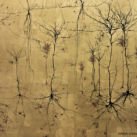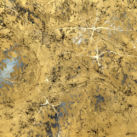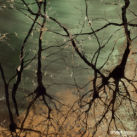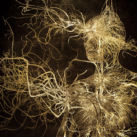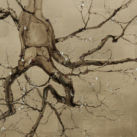But not for lack of trying.
Working with physicist Brian Edwards, Dunn developed an artistic process he calls “microetching” to better capture the complexity of the human control center.
Microetching begins with a two-dimensional image created by Dunn. The image is then scanned and encoded using Edwards’ algorithm. The result is a sheet of gold leaf, engraved on a microscopic scale.
The process adds another dimension and depicts how the brain works through reflections of light. When his art is on display, Dunn uses different colored lights and angles to change the work’s appearance based on where the viewer is standing.
The resulting image depicts the movement of individual neurons. Neurons are cells that generate messages by reacting to external stimuli and their internal environment. Several of Dunn’s pieces also depict glia, non-neural cells also found in the brain.
“Each individual neuron has a very limited understanding of what’s happening in the brain,” Dunn said. “Their collective opportunity is so much greater than an individual unit. That concept of emergence from a zillion far less complex parts, resulting in something much more complex, is of great artistic importance to me.”
When it comes to his microetchings, Dunn hopes that people walk away with an appreciation of the beauty and complexity of our brains.
“What a monumental task it is for scientists to try to make sense of them whatsoever,” said Dunn, who received his doctorate in neuroscience from the University of Pennsylvania in 2011. “I hope that an average person, who really doesn’t know much about the brain, that my pieces give them a sense that the beauty of nature extends beyond our ability to see with our naked eyes.”
Dunn also produces paintings on a scroll. One of these, titled “Alzheimer’s Tangles” depicts the abnormal tangled structures formed from diseased neurons that make a defective protein. Dunn’s maternal grandfather passed away from dementia around 2010.
Depicting the brain in his art began for Dunn while in graduate school. While using art as an outlet for the stress of graduate school, he drew upon the beauty of what he was studying every day: the brain.
Dunn is wrapping up a showcase of his work “Mind Illuminated” in Philadelphia. His work is also on display in Boston and Baltimore. More information can be found on gregadunn.com.


